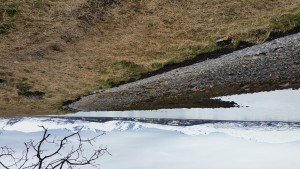From: Wim Vader <wjm.vader@gmail.com>
Sent: lørdag 15. mai 2021 12:21
To: Willem Jan Marinus Vader <wim.vader@uit.no>
Cc: Hayo H.W. Velthuis <hhwv@xs4all.nl>; Jan Willem Vader <jw.vader@chello.nl>; Lena de Vries <lenajee@ziggo.nl>; Riet Keuchenius <mmkeuchenius@gmail.com>
Subject: A walk through Fagerengfjaera
A walk through Fagerengfjaera
15 May, grey skies, our garden, at 45m a.s.l., is still c 60% snow covered. My hanging sunflower seed feeder is still very little popular, but this morning 2 Greenfinches came to take a few seeds. As always, the local Magpies are around and Hooded Crows fly over.
Our home is in suburbia; the town center is on the opposite side of the island–many Kittiwakes there now, but we never see one here.
Our street, Vesterlivegen, abuts Folkeparken, a woodland of birches, mountain ash, pines and spruce (the latter 2 not wild locally). Just this last week the thrushes have returned here and now there are bold Fieldfares and cautious Redwings everywhere, while also the tired sounding rasps of the beautiful Bramblings can be heard here and there, although the Greenfinches still dominate the rasp-chorus.
Vesterliveien descends quite steeply to the shore of Sandnes-sundet, one of the 2 sounds that surround Tromsoeya and that make out the sill of the long and deep Balsfjord. Here there is a field of a few hundred meters still lying fallow and this is Fagerengfjaera, which translates as ‘beautiful meadow shore’. Now beauty is in the eye of the beholder, of course; this is rough grassland, soon absolutely dominated by the white Cow Parsley Anthriscus flowers and the enormous and not indigenous Tromsoe Palms Heracleum, later in the season replaced by the creamy white of Meadowsweet Filipendula. But now, the snow just gone, it does not look all that alluring, although both Anthriscus and Heracleum show their first green and along the paths the characteristic leaves of the Lady’s Mantle Alchemilla unfold. This is one of the last areas on the island where the stony intertidal is still more or less intact. This makes the area of course popular by builders, and plans to remake the area with 13 large apartment buildings and even an artificial little island (so-called nature) just outside have just been, I fear only temporarily, stopped.
When I walked here a few days ago, there was little to be seen and the Greylag Geese that were there earlier, had left for more promising nesting areas. But this day I was more lucky. Even before I had descended to the area proper, I discovered the first Pied Wagtail of the year, on a house roof; this bird is very popular here and prefers to nest close to humans. Along the rough path along the coast there were as always lots of Common Gulls–they nest in the area in a very loose colony–, with Herring Gulls, Great Black-backed Gulls and to a degree also Oystercatchers keeping more to the intertidal. Here there are also many Common Eiders now, in pairs or still small flocks; the females will soon find a nesting place. A few lone Mallard drakes show that these females already may be nesting.
But I hear a different melancholy, but very welcome sound: the first Golden Plovers have arrived, also these already in pairs.
A lady walking her dog who wondered what kind of birds these were, told me that they had been there already a few days. Now I saw at least 3 pairs. And there was still a different sound (I am very lucky that my steadily increasing deafness hits the high frequencies much less severely!), also as well known as welcome: a pair of Redshanks! That made for no less than 3 year-birds on a quite short walk, a very good day!
Wim Vader, Tromsoe, Norway

